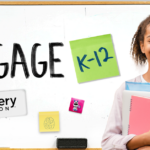By Amanda C. Jones, Ed.D.
Amid the global pandemic, students across the nation have been forced out of schools and are now learning from home. This has left many educators scrambling to determine how to best to bridge the learning divide and meet the challenges of continuing to engage students. However, the COVID-19 crisis has also provided educators an opportunity for reflection on practice.
The call for a paradigm shift to 21st century learning is not new.
We are more than 20 years into the 21st century, yet schools and districts across the nation continue to pursue ways to better meet the needs of today’s learners. As a former principal and current district coordinator in the Mobile County Public School System in Mobile, Alabama, proven success has been discovered through the implementation of the following four intentional actions which lead to a cultural shift in education and better prepares students to meet the challenges and opportunities presented in the 21st century.
Action #1: Grow Community
Building a strong community is among the first actions needed when transforming a learning culture. Educational landscapes typically mirror the workforce, and during the Industrial Age, much of education was modeled after factory standardization- compliance based, desk in rows, and independent tasks. The Information Age has transformed the way schools operate and has created new opportunities for how we learn, work and communicate. We are now able to connect on a global scale with the push of a button. Building community provides students with the opportunity to think critically, see how their learning relates to the world beyond the “walls” of their school. There are many ways to “grow community” within your classroom, school, and district.
The use of school mottos or mantras, themes, quotes or hashtags is one simple way to begin this shift. Try utilizing a theme or quote each quarter and tie learning objectives to that theme. Sharing a common theme provides connection for all students. You can also take the additional step of having this theme correspond directly to a quarterly cross curricular project. The use of PBL in this way makes the learning more relevant to students.
Encouraging teachers to engage in professional learning communities beyond their school or district will also assist them in growing professionally. I am involved in the DEN (Discovery Education Network) community and have benefited from a wealth of information provided by other educators. Many have also found Twitter to be a great way to establish a PLN (professional learning network).
Growing a school community should also involve the outside community. Find ways to involve business leaders, parents, entrepreneurs, and political leaders within your school, classroom, or district.
Leverage technology to grow community. The use of digital school news and announcements is the perfect way to build community and an excellent platform to share school-wide mottos, quotes, or themes. The use of social media outlets provides opportunity to connect your school with the “outside world” and share your school or district’s story. Districts, schools, and classrooms with established community have more easily remained connected through the current health crisis.
Action #2: Grow Experiences
As educators, we have the gift of opening the door to endless possibilities for our students. Our students come from all walks of life, and to level the playing field for students they must be afforded various experiences, so they learn their passions and interests. Learning should be relevant and connected to real-world experiences as much as possible. The use of project or problem-based learning is one way to provide learning in context of a real-word situation.
Students should own their learning. To better engage students in learning, let’s offer them the opportunity to explore all that learning has to offer. Offering a variety of club or elective opportunities within the school day is another way for students to be exposed to various interests in an equitable manner.
Schools can also provide experiences through the creation of makerspaces, innovative emerging technologies labs, communication labs, STEM, entrepreneurial skills, the arts, and through effective use of the school media center. With the accessibility of virtual reality and technology that allows connection with the outside world, our students can gain experiences and be introduced to places through virtual field trips and global events that far exceed anything we could have imagined prior to the digital-age. Legitimate field trips also offer new experiences for our students.
Also, tap into learning resources that provide opportunities for students to explore, create, and connect their learning to the world. Resources such as PBL Works, Discovery Education, EntreEd and Nearpod are a few that offer teachers access to real-world learning tools, and a quick internet search would likely provide more.
Action #3: Use Creative Scheduling
Offering a variety of student experiences and real-world learning experiences is nearly impossible without the use of creative scheduling. Why are we continuing to use the same bell-schedules and isolated class structures that have been used for over one hundred years? Is it because that’s “the way it’s always been done”?
Do not allow traditional structures and “Flintstonian” whistles to dictate how your students move and learn throughout the school day. If your traditional scheduling structure does not allow opportunities for your students to visit labs, create, pursue interests and passions, and engage in cross-curricular, relevant learning, then it is time to get creative with your scheduling to allow for those opportunities.
Action #4: Leverage Technology for Good BUT Focus on SKILLS
The great technology debate is ongoing. Are there benefits to using technology as a learning tool? It seems obvious considering COVID-19, that technology can be a beneficial learning tool if used well. Are their risks associated with technology? Of course.
As educators, we TEACH, and in today’s world if we are not teaching HOW to safely utilize technology as a learning and communication tool then we are failing children. Interestingly, many schools who were banning certain device use within classrooms found themselves needing students to use those same devices at home to continue education.
It is our job as educators to teach students how to responsibly use technology to communicate, collaborate, think critically, and create. Just as we teach young students how to safely use scissors as a tool, we also must teach students how to safely utilize technology as a tool.
Rather than getting wrapped up in the type of technology, platforms, or programs to use, let’s instead focus on HOW technology is being used to advance 21st century skills. Technology isn’t always required to foster communication, collaboration, creativity, and critical thinking, but the use of technology can certainly enhance these skills.
Transforming education is not an easy task, but taking these four intentional actions will begin the shift that’s necessary to prepare our students for their global society. Each of these actions can be taken within the traditional school setting, but they also enhance the learning culture by promoting skills that students can use when faced with any circumstance, even if it means learning from home.
It’s time to bridge the 21st century learning divide, and it begins with each of us.

Amanda C. Jones, Ed.D., is Coordinator of Professional Learning, Special Projects and Innovation at Mobile County Public School System. She’s also a member of the Discovery Educator Network and she serves on the Board of Directors for the Consortium for Entrepreneurship Education.
The American Consortium for Equity in Education, publisher of the "Equity & Access" journal, celebrates and connects the educators, associations, community partners and industry leaders who are working to solve problems and create a more equitable environment for historically underserved pre K-12 students throughout the United States.
- American Consortium for Equity in Educationhttps://ace-ed.org/author/admin/
- American Consortium for Equity in Educationhttps://ace-ed.org/author/admin/April 23, 2025
- American Consortium for Equity in Educationhttps://ace-ed.org/author/admin/
- American Consortium for Equity in Educationhttps://ace-ed.org/author/admin/







